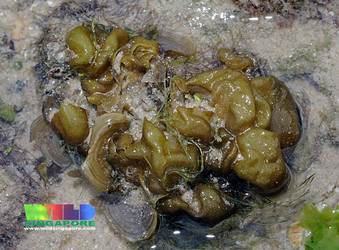Phaeophytes
Brown Algae
Introduction
The phaeophytes (brown algae) make up roughly 1500-2000 species in 250 genera. They are photosynthetic members of the stramenopiles that range in size from the 50 m giant kelp that produce the kelp forest off the west coast of North America to microscopic filaments. Brown algae are typically epilithic from the intertidal to the deep subtidal and can reach depths of >60 m (Graham et al. 2007). However, they can also grow epiphytic and occasionally endophytic (e.g. Laminariocolax spp.) or pelagic (e.g. Sargassum spp.).
From an ecological perspective, brown algae are the dominant intertidal and shallow subtidal macroalgae in many marine habitats. In the Northern Hemisphere, temperate to arctic coastlines are covered by members of the Laminariales in the Pacific and both the Fucales, and to a lesser extent, Laminariales in the Atlantic. In the tropics, members of the Dictyotales have a worldwide distribution and the coastline of the Southern Hemisphere is dominated by genera of the Fucales and Laminariales largely absent in the Northern Hemisphere. Particularly in cooler waters, brown algae provide important shallow water habitat for an enormous variety of fish and invertebrate species.
Characteristics
There are no unicellular brown algae, though nearly all members have characteristic unicellular biflagellated spores in their life cycle, typical of stramenopiles. Flagella are laterally inserted, with the anterior-facing flagellum possessing tripartite mastigonemes and the posterior-facing (whiplash) flagellum naked. Eyespots are often present in the spores, associated with the plastid.Brown algal plastids are derived from a secondary endosymbiotic event involving a red algal cell (see Archibald, 2009; Keeling 2009; Lane & Durnford, 2010). Thus plastids in the phaeophytes (and all photosynthetic stramenopiles) are related to red algae and are surrounded by four membranes with thylakoids in stacks of three (Kim & Archibald 2008). The primary pigments of brown algae are chlorophylls a and c, as well as the carotenoid, fucoxanthin.
Reproduction can be both sexual, or asexual, in brown algae and some form of alternation between free-living haploid and diploid generations (iso- or heteromorphic) is nearly universal. Asexual reproduction can occur in the diploid sporophyte phase of the life history by way of either mitotic divisions within plurilocular sporangia (2n) that result in the recapitulation of the sporophyte, or meiotic divisions in unilocular sporangia, resulting in haploid (1n) spores that germinate into the gametophyte phase. The gametophyte produces gametes through mitotic divisions in plurilocular gametangia. In many cases the haploid gametes (spores) can settle and develop directly back into a gametophyte if they do not fuse with another gamete.
References
Graham, M. H., Kinlan, B. P., Druehl, L. D., Garske, L. E., Banks, S. (2007) Deep-water kelp refugia as potential hotspots of tropical marine diversity and productivity. Proc. Nat. Acad. Sci. USA. 104:16576-16580
Title Illustrations

| Scientific Name | Padina sp. |
|---|---|
| Location | Singapore |
| Comments | More about this seaweed on the wildfacts sheets on wildsingapore. For a high res version of this photo, please review the details on about using my photos. When making the request, please include this reference: 100102tkkd7148 |
| Specimen Condition | Live Specimen |
| Source | Mermaid's fan (Padina sp.) |
| Source Collection | Flickr |
| Image Use |
 This media file is licensed under the Creative Commons Attribution-NonCommercial-NoDerivs License - Version 2.0. This media file is licensed under the Creative Commons Attribution-NonCommercial-NoDerivs License - Version 2.0.
|
| Copyright | © 2010 Ria Tan |
| Scientific Name | Colpomenia sp. |
|---|---|
| Location | Singapore |
| Comments | More about this seaweed on the wildfacts sheets on wildsingapore. For a high res version of this photo, please review the details on about using my photos. When making the request, please include this reference: 100102tkkd7178 |
| Source | Puffy brown seaweed (Colpomenia sp.) |
| Source Collection | Flickr |
| Image Use |
 This media file is licensed under the Creative Commons Attribution-NonCommercial-NoDerivs License - Version 2.0. This media file is licensed under the Creative Commons Attribution-NonCommercial-NoDerivs License - Version 2.0.
|
| Copyright | © 2010 Ria Tan |
About This Page
This page is being developed as part of the Tree of Life Web Project Protist Diversity Workshop, co-sponsored by the Canadian Institute for Advanced Research (CIFAR) program in Integrated Microbial Biodiversity and the Tula Foundation.
Page copyright © 2010
All Rights Reserved.
- First online 28 April 2010
- Content changed 24 May 2010
Citing this page:
Tree of Life Web Project. 2010. Phaeophytes. Brown Algae. Version 24 May 2010 (under construction). http://tolweb.org/Phaeophytes/129402/2010.05.24 in The Tree of Life Web Project, http://tolweb.org/










 Go to quick links
Go to quick search
Go to navigation for this section of the ToL site
Go to detailed links for the ToL site
Go to quick links
Go to quick search
Go to navigation for this section of the ToL site
Go to detailed links for the ToL site